FEATURES|THEMES|Social Engagement
The Khyentse Foundation Leadership Project: Teaching Leadership and Management in Tibetan Buddhist Monasteries
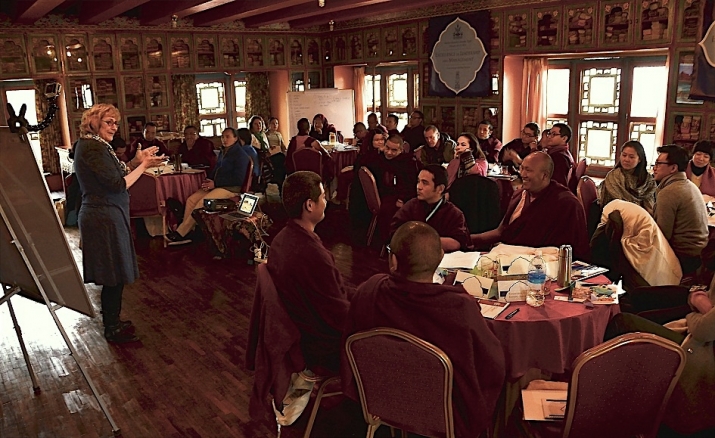 Sydney Jay leading a group discussion. Photo by Stacey Stein
Sydney Jay leading a group discussion. Photo by Stacey SteinThe walls have been covered in yellow silk, hiding the shrine. Six large, round tables stand where the monks usually sit to do pujas. The overhead projector is displaying the Khyentse Foundation Leadership Workshop splash screen on a large screen—or rather, on a large, white sheet hung from the rafters. There are six whiteboards, seven chairs at each table, and a side table for faculty, made up of professionals from China, North America, Europe, and Nepal. The microphones have been tested and retested. The tulkus (incarnate lamas), Khenpos (learned scholars and abbots), acharyas (teachers), and the few lay participants, along with the faculty and translators, stand waiting for the Rinpoche who is sponsoring the workshop at his monastery. He arrives; we all bow and offer katags (ceremonial scarves) with the usual protocol. I stand close to Rinpoche’s seat at the front table, my head lower than Rinpoche’s as he approaches, and welcome him to the workshop.
In 2008, Dzongsar Khyentse Rinpoche asked my wife Sydney and I if we could bring the kind of leadership workshop that we run for global management consulting firm McKinsey & Co. to his monasteries in India and Bhutan. “Bring them into the 21st century and don’t piss them off,” he said. At McKinsey, for over ten years we had been training young consultants who are the top graduates from their universities. At other companies, we had trained and coached shrewd senior executives. But monks? Few have ever been taught English, math, science, government, or social studies—the essential educational background that we take for granted. As Sean Price, a monk and translator at Shechen Monastery in Nepal told us, the language of modern organizational dynamics, leadership, and management does not even exist in Tibetan. With our able team of translators, we would be creating a new language.
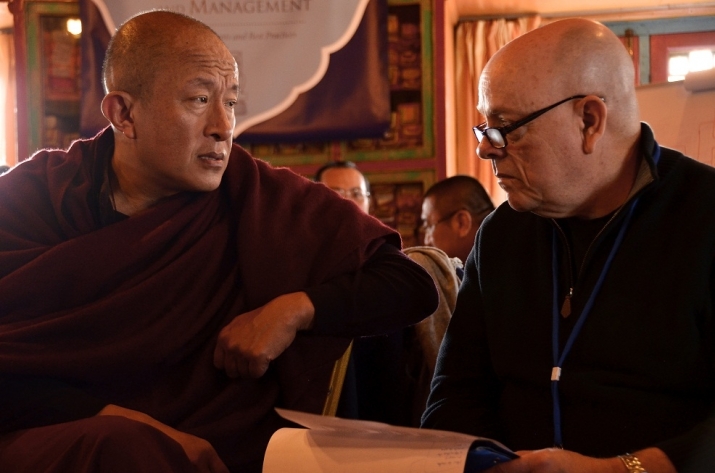 HE Dzongsar Khyentse Rinpoche and Chris Jay. Photo by Stacey Stein
HE Dzongsar Khyentse Rinpoche and Chris Jay. Photo by Stacey SteinYear 1 at Dzongsar Institute, Chauntra, Himachal Pradesh, India. We brought classical problem solving, communication tools such as listening and asserting, leadership games, a set of quotes from business leaders. They loved it. But “problem”? “Please don’t call regular organizational issues a ‘problem’ and talk about ‘problem-solving’—a ‘problem’ is that the snow is too deep to wade through so we cannot get across the Himalayas on this path, and we cannot turn back to Tibet. That’s a ‘problem.’ ”
Classical “problem solving” uses tools such as an Issue Tree. We noticed in Year 1 that the same kind of structured thinking exists as the “structural outline” of the philosophical texts that the monks study. So, using that logic, we told them, “You are given a structural outline to memorize when you begin studying a classical philosophical text such as the Madhyamakavatara. Now, you have to create your own structural outline for an issue that your monastery is facing.” The biggest issue for Year 1: “How can we reform our curriculum and teaching methodology?”
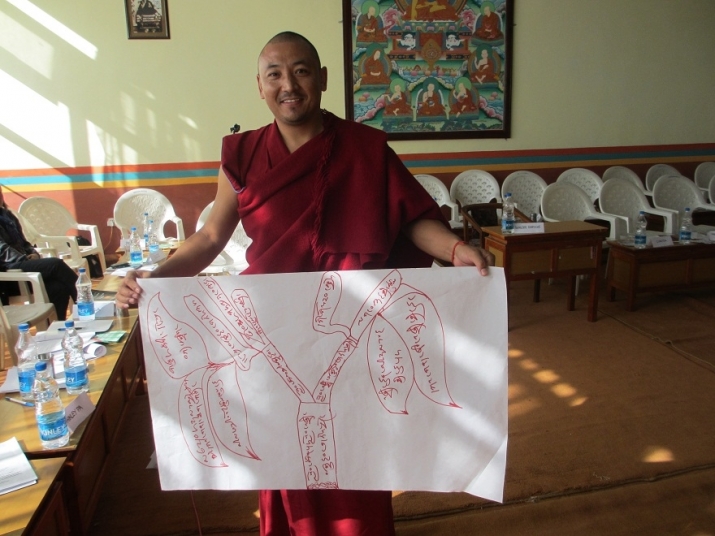 Khenpo from Dzongsar Institute with his Issue Tree drawn as a tree
Khenpo from Dzongsar Institute with his Issue Tree drawn as a treeYear 2 at DI: We added in MBTI (Meyers-Briggs Type Indicator, a psychometric instrument that measures individual operating styles, originally conceived by Carl Jung). Just try translating the assessment instrument into Tibetan, in which few of the words actually exist! Nonetheless, we did it, and the monks were delighted. The best part was watching them arguing with each other—in full debate style at lunch—about which of the 16 types was the best.
Year 3 at DI: More of the same, but with more games. See-Run-Do was the winner that year. In this game, for each team there is one Seer, one Runner, and four or five Doers. The Seer can see a flip chart page that has a pastoral scene made of cut paper of various colors. The Seer has to tell the Runner what the picture is, just by talking about the shape and size of the elements. The Runner can’t see the picture, but he has to run back to the Doers and tell them what to make. The Doers have paper, scissors, glue, and a blank flip chart page, and stand there waiting for the Runner, who is not allowed to see what the Doers are making. This very accurately simulates what happens in most organizations around the world: the top person gives orders to someone, who has to communicate to the rest—who all have their own feelings and thoughts about the task, and about the Seer and Runner as well. At the end of the debrief, one Khenpo, who is a member of the Tibetan Parliament in Exile, stood up and said, “All Tibetans should be required to go through this exercise.”
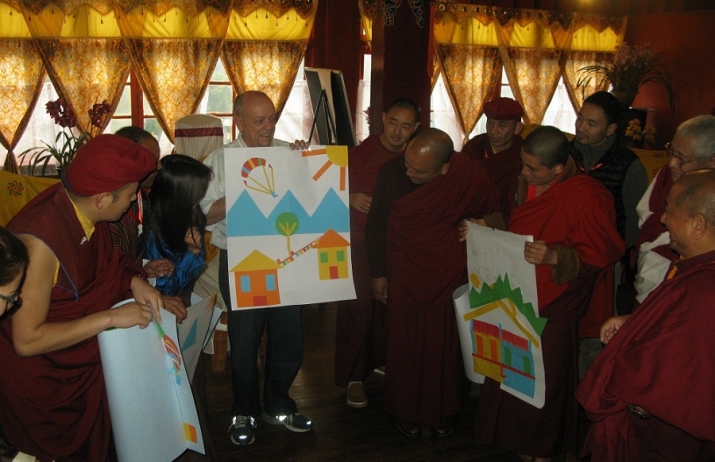 Drukpa Thuktse Rinpoche looks on as the winning team shows their See-Run-Do poster
Drukpa Thuktse Rinpoche looks on as the winning team shows their See-Run-Do posterWe set up this game as a competition in which only one team wins. If you think McKinsey consultants are competitive, you have never seen monks competing with each other—yelling, running, teasing, laughing. At one program, one of the greatest young Yangsis (high incarnations) dove head first down the stairs because he was a Runner and wanted to beat the other Runners.
In 2014, Dzongsar Khyentse Rinpoche told us he wanted to do a program for a large group of Rinpoches (senior lamas)—including himself. With Anya Hartmann, a former partner of McKinsey, we polished our workshop design. Khyentse Yangsi hosted the workshop at Shechen Monastery in Nepal, and present were top Rinpoches from the Nyingma, Karma Kagyu, Drukpa Kagyu, and Sakya lineages. Since then, several of the participating Rinpoches have sponsored this same workshop at their own monasteries.
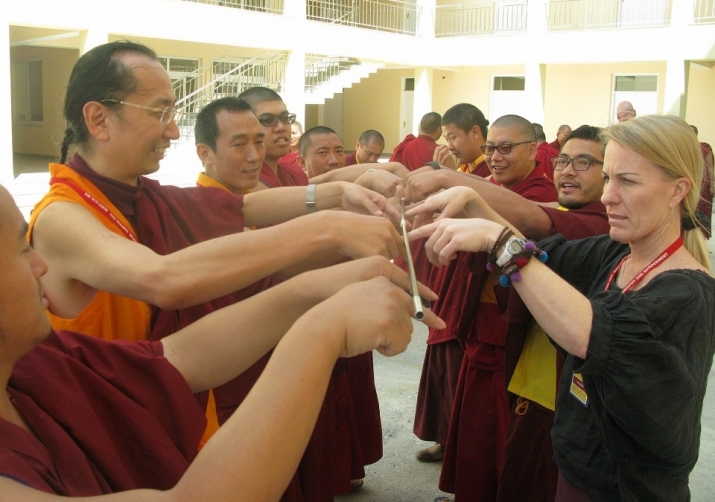 Helium Sticks—a game more challenging than it seems, with HE Ratna Vajra Rinpoche
Helium Sticks—a game more challenging than it seems, with HE Ratna Vajra RinpocheSo, what need is this workshop addressing? And what challenges are the Rinpoches and monastic leaders facing now? As Dzongsar Khyentse Rinpoche said, “In Tibet, if a family had three sons, they sent their best son to the monastery. Now if they have three sons, they send their worst—if they even send one.” There are 2.6 billion Christians in the world, and 1.2 billion Muslims. Islam is the fastest growing religion. Buddhism is practiced by less than 500 million, half of whom are in China. It is not growing at all and in some places is receding in the face of Islam.
As Drukpa Thuktse Rinpoche put it during a program we conducted at his monastery in Darjeeling, the Jesuits are down in the villages every week, getting to know the families, the children, and the troubles they are facing. They bring solutions to problems such as health and water. The Buddhists? We are up there on the hill in the monastery doing pujas. If you are a young mother, who do you go to for help, material and spiritual? So, we Buddhists need to get out of our monasteries and get into the communities.
After three years, rather than “problem,” we decided to use the term “Central Question.” Here are some of the Central Questions that we have seen the seven-person table groups work on in our recent workshops:
- How can we reform the curriculum and teaching methodologies in our shedras (study centers)?
- How can we modernize our monastic library so that it is used in the same way as libraries in Western universities?
- How can our shedra connect with a modern university so that university students can get college credit for taking courses at our shedra?
- How can we get closer to the laypeople and provide services that they need?
- How can we improve the lot of stray dogs in Kathmandu and other places?
- How can we improve the quality of our teachers and students—without sacrificing the traditional methodologies?
- How can we connect with people in China who want to hear the Dharma?
- How can we use app technology to teach the Dharma?
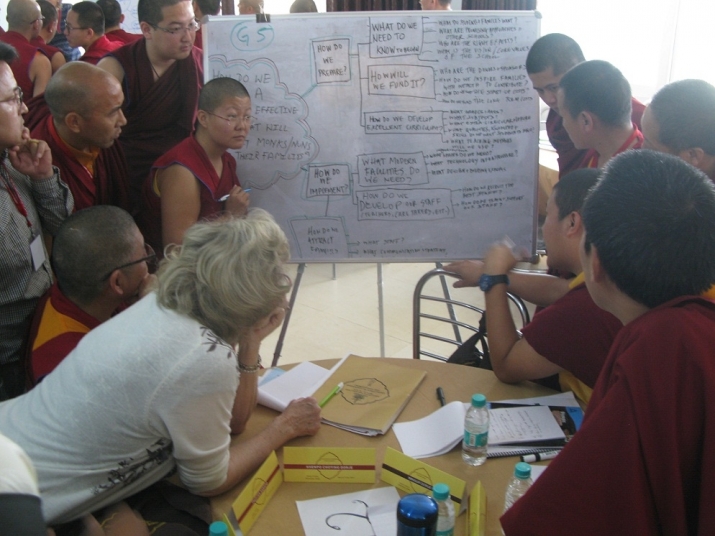 Team working on Central Question
Team working on Central QuestionThese are serious questions, and together with our faculty and translators, we work with them in ways that are light, fun, interesting, and ultimately, we hope, helpful in the long term to the workshop participants. It is our aspiration as a faculty that the work we do support the compassionate intention of the Tibetan Rinpoches, Khenpos, monks, and nuns so that their influence is felt at the highest levels—and at all levels—throughout the world, in ways that are modern and smart, built on powerful traditions, and focused on solutions for the future.
Chris Jay is a partner of The Exetor Group, a global leadership development consulting firm. Chris began studying and practicing the Dharma in 1970 at Daitoku-ji, a Rinzai Zen temple in Kyoto, Japan. He spent seven years there, four years as a novice and three years as a fully ordained monk. He became a student of Dzongsar Khyentse Rinpoche in 1997, and in 2008, completed a three-year retreat under his guidance. He lives in Seattle and holds an MBA from the University of California at Berkeley.














